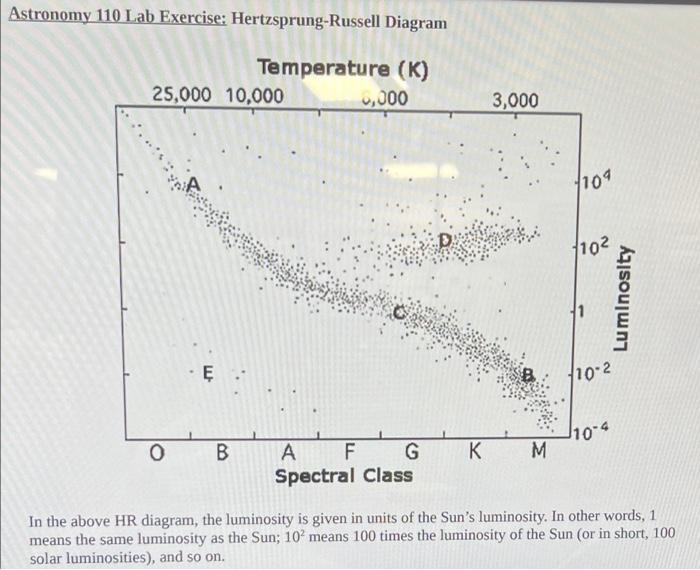Answered step by step
Verified Expert Solution
Question
1 Approved Answer
This is for astronomy; please help Astronomy 110 Lab Exercise: Hertzsprung-Russell Diagram Temperature (K) 25,000 10,000 0,000 3,000 1709 D 102 Luminosity . 102 110-4
This is for astronomy; please help 

Astronomy 110 Lab Exercise: Hertzsprung-Russell Diagram Temperature (K) 25,000 10,000 0,000 3,000 1709 D 102 Luminosity . 102 110-4 O B K M A F G Spectral Class In the above HR diagram, the luminosity is given in units of the Sun's luminosity. In other words, 1 means the same luminosity as the Sun; 10' means 100 times the luminosity of the Sun (or in short, 100 solar luminosities), and so on. Part 3: Lifetimes of Stars In the previous section, you showed that the size of a star can be inferred through its temperature and luminosity. Star D lies on the red giant branch, while star E lies in the white dwarf region of the HR diagram. The other stars (like the Sun) lie on the main sequence where they are fusing hydrogen into helium in their cores. Now we will investigate the lifetimes of stars on the main sequence. 11. Among the main sequence stars A,B, and C, which star is the hottest and brightest? 12. Which of the main sequence stars (A,B,C) do you think is the most massive? Which is the least massive? Explain. (Hint: think in terms of gravity. The more massive the star, the greater the force of gravity squeezing its core. What happens to the temperature of a gas when you squeeze it? Use this to decide whether a hotter star should be more/less massive than a cooler star, and explain your reasoning.) 13. Which of the main sequence stars (A,B,C) burns its hydrogen at the fastest rate? Explain. 14. Consider the following statement given by student 1: "Since type O stars are more massive, they carry the largest amount of hydrogen in their cores. Since they have more fuel to burn, they must have the longest lifetimes." In fact, this is not the case: type O stars can have lifetimes as "short" as a million years, whereas type M stars can live for 100 billion years or longer. What is wrong with student 1's reasoning? Why do type M stars live longer? Explain 

Step by Step Solution
There are 3 Steps involved in it
Step: 1

Get Instant Access to Expert-Tailored Solutions
See step-by-step solutions with expert insights and AI powered tools for academic success
Step: 2

Step: 3

Ace Your Homework with AI
Get the answers you need in no time with our AI-driven, step-by-step assistance
Get Started


